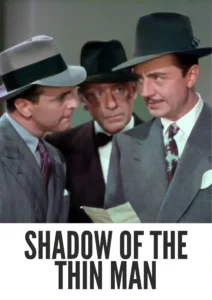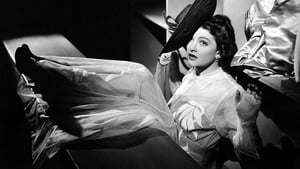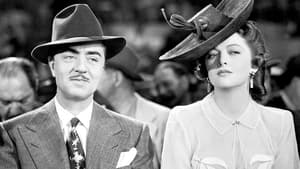Video Sources 0 Views

Synopsis
Mystery, Glamour, and Murders: Shadow of the Thin Man (1941) in Dazzling Color

Step back into the sophisticated world of crime-solving with Shadow of the Thin Man, a delightful romantic crime caper from 1941, now beautifully colorized for a viewing experience that pops! Starring the charismatic duo of William Powell and Myrna Loy, this installment in the Thin Man series delivers a perfect blend of mystery, wit, and glamour. Perfect for fans of classic detective stories and sparkling banter, this HD download brings a beloved cinematic treasure to life. Also known as The Shadow, this film promises an evening of stylish intrigue and entertainment.
Shadow of the Thin Man Storyline: A Night at the Races Turns Deadly
Shadow of the Thin Man finds Nick and Nora Charles embroiled in another perplexing case, this time set against the backdrop of a bustling racetrack. When a jockey is murdered, suspicion falls on several individuals connected to the track, including gamblers, owners, and fellow racers.As Nick investigates, he navigates a complex web of relationships and alibis, uncovering secrets and hidden motives along the way. Nora, as always, provides her invaluable assistance, offering witty observations and keen insights. The couple’s charming banter and undeniable chemistry add a delightful layer to the suspenseful plot. In a race against time, Nick must unmask the killer before they strike again. Shadow of the Thin Man is a captivating blend of mystery and humor.
Movie Cast
The film features a stellar cast of actors who bring this glamorous mystery to life:
- William Powell as Nick Charles
- Myrna Loy as Nora Charles
- Barry Nelson as Paul Clark
- Donna Reed as Molly Ford
- Sam Levene as Lieutenant Abrams
Movie Genre
Shadow of the Thin Man falls into the genre of romantic crime caper, blending elements of mystery, comedy, and romance. Its sophisticated humor and stylish setting make it a standout in classic cinema.
Historical Context: The Thin Man Series and Wartime Hollywood
Released in 1941, Shadow of the Thin Man was part of the highly successful Thin Man series, known for its witty dialogue and charming leads. Produced during the early years of World War II, the film offered audiences a welcome escape from the anxieties of the time, providing lighthearted entertainment and a touch of glamour. The Thin Man series remains a beloved example of Hollywood’s Golden Age, showcasing the talents of its stars and the craftsmanship of its filmmakers.
Colorization Details
This colorized version of Shadow of the Thin Man has been meticulously restored using modern digital techniques, enhancing the visual appeal while preserving the film’s original charm and sophistication. The colorization process involved carefully analyzing the grayscale tones of the original black and white footage and assigning appropriate colors to each scene. While the specific software used remains proprietary, the techniques employed included advanced algorithms for color palette selection and image enhancement. This painstaking process brings new life to the characters and settings, making the story even more engaging for modern audiences. Whether one appreciates colorizing classic films or not, it exposes these classics to a wider audience.
Technical Details
- Director: W.S. Van Dyke
- Screenplay: Harry Kurnitz, Irving Brecher
- Story: Harry Kurnitz
- Cinematography: Karl Freund
- Edited by: Albert Akst
- Production Company: Metro-Goldwyn-Mayer
- Distributed by: Metro-Goldwyn-Mayer
- Runtime: 97 minutes
Technical Specifications
- Download Format: MP4
- Resolution: HD (1080p)
- Compatibility: Compatible with most devices, including smartphones, tablets, computers, and smart TVs.
Reviews and Critical Reception
Shadow of the Thin Man (1941) is celebrated as a delightful entry in the Thin Man series, praised for its witty dialogue, charming performances, and engaging mystery. The film’s blend of humor and suspense continues to captivate audiences, making it a beloved classic of the genre. As a shining example of Hollywood’s Golden Age, Shadow of the Thin Man offers a nostalgic and entertaining viewing experience.
FAQs
- Q: What is Shadow of the Thin Man about?
- A: Shadow of the Thin Man is a romantic crime caper about Nick and Nora Charles solving a murder at a racetrack.
- Q: Is Shadow of the Thin Man (1941) part of a film series?
- A: Yes, Shadow of the Thin Man is part of the popular Thin Man series, known for its witty dialogue and charming leads.
- Q: Is this version of Shadow of the Thin Man colorized?
- A: Yes, this version has been professionally colorized to enhance the viewing experience.
- Q: What makes Shadow of the Thin Man a classic?
- A: Shadow of the Thin Man is a classic due to its blend of humor, mystery, and the charming chemistry between William Powell and Myrna Loy.
- Q: What is the download format?
- A: The download format is MP4, which is compatible with most devices.
- Q: What resolution is the download?
- A: The resolution is HD (1080p), providing a high-quality viewing experience.
Download Now in HD!
Watch Shadow of the Thin Man Today!














